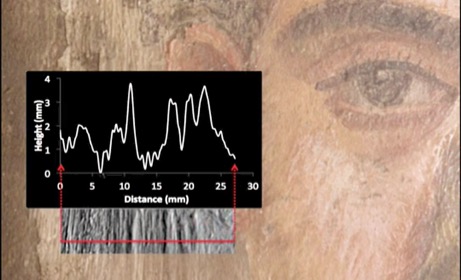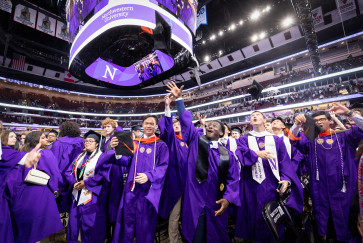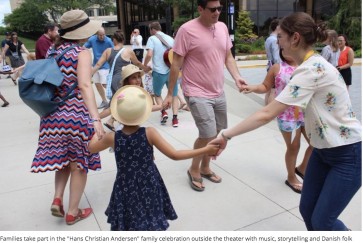EVANSTON - The Block Museum of Art and the McCormick School of Engineering at Northwestern University delve into the art and science of ancient artifacts in the upcoming exhibition “Paint the Eyes Softer: Mummy Portraits from Roman Egypt,” opening Jan. 13, 2018.
“Paint the Eyes Softer” brings to Northwestern a series of mummy portraits produced in Egypt during the Roman period, a complete intact portrait mummy and other archeological finds from the Fayum region. Combining expertise from across the University — including contributions from classics, art history, sound design, materials science, medicine, archeology, art history and molecular biology — this groundbreaking installation explores how interdisciplinary partnerships can deliver new insights into ancient mysteries.
The exhibition is presented as part of an ongoing art and engineering partnership between the McCormick School of Engineering and the Block Museum that has included visiting artists, exhibitions and residencies focused on the productive intersections of creativity and scientific research.
“This unique exhibition is quintessentially Northwestern, arising from the DNA of the institution that values partnership and interdisciplinary inquiry,” said Lisa Corrin, the Block Museum Ellen Philips Katz Director. “Our students and faculty are able to come to significant, field-advancing findings by collaborating across multiple fields of expertise.
“This exhibition not only brings to Northwestern some of the most significant early portraits in existence, but demonstrates the way that art and engineering can come together in extraordinary ways,” Corrin said.
“This exhibit is just one of the many ways we are continuing to expand the intersection between art and engineering,” said Julio M. Ottino, dean of the McCormick School. “In addition to providing the tools of engineering to study the history of art, our partnership provides opportunities for engineers and artists to learn how each other works and thinks, expanding their own abilities in the process.”
“Paint the Eyes Softer” is co-curated by Marc Walton, research professor of materials science and engineering at Northwestern and senior scientist at NU-ACCESS; Taco Terpstra, assistant professor of classics and history at Northwestern; and Essi Rönkkö, Block Museum curatorial associate, in consultation with an interdisciplinary group of Northwestern student researchers.
 Three mummy portraits, second century CE, encaustic on wood. Phoebe A. Hearst Museum of Anthropology; 6-2378b; 6-21377; 6-21379. Courtesy of the Phoebe A. Hearst Museum of Anthropology and the Regents of the University of California.
Three mummy portraits, second century CE, encaustic on wood. Phoebe A. Hearst Museum of Anthropology; 6-2378b; 6-21377; 6-21379. Courtesy of the Phoebe A. Hearst Museum of Anthropology and the Regents of the University of California.
Ancient Portraits
On view within the exhibition will be a series of rare Roman-Egyptian funerary portraits. Painted on wooden panels between the first and third centuries CE in Egypt, these visages of the dead were originally secured over the face of the deceased within the mummy wrappings.
When these works were excavated at the beginning of the 20th century, they transformed the world with their immediacy, thought to reveal naturalistic, individual likenesses of people who lived 2,000 years ago. Some of the earliest portraits in existence, these paintings offer viewers a face-to-face encounter with the past. The words on one sketch board still bear personal instructions to an artist of an earlier millennium: “(paint the) eyes softer,”it indicates in Greek.
The majority of the objects on view at the Block, excavated from the site of Tebtunis (now Umm-el-Breigat, Egypt), are loans from the Phoebe A. Hearst Museum of Anthropology at the University of California, Berkeley. One of the largest collections of Roman portraits to have remained intact since excavation, they present a rare opportunity to study the material microhistory of painting tradition in a known context and to explore how ancient paintings were created.
“It is extremely exciting to have not only a large number of rare mummy portraits on display but also the only known annotated sketch of what was to become yet another portrait,” Terpstra said. “It represents a moment frozen in time. We are witnessing the process of artistic creation, providing a unique experience for the curators as well as the visitors to the exhibit. I would like to add that I am really proud of both our Weinberg College and McCormick School students. They have done a fantastic job of getting the most out of this fascinating material.”
 Northwestern students working in joint classics and material studies course investigate the mummy in Marc Walton’s lab
Northwestern students working in joint classics and material studies course investigate the mummy in Marc Walton’s lab
The Mummy Portrait Project: Exhibition as Laboratory
In addition to the objects themselves, “Paint the Eyes Softer” will foreground innovative techniques for the scientific study of objects. In recent years, the paintings have been the focus of a systematic study conducted by NUACCESS (Northwestern University/Art Institute of Chicago Center for Scientific Studies in the Arts) and UC Berkeley using a variety of imaging techniques. Recent scientific analysis conducted by NU-ACCESS has determined that some of the wood used in the creation of the panels was local, while some of it was brought in from the Balkans in southeastern Europe, opening interesting questions about local economies and long-distance trade. [Learn more about The Tebtunis Project]
Students enrolled in a Fall 2017 advanced undergraduate seminar are working with exhibition curators Terpstra and Walton to continue the research of the NU-ACCESS project, combining materials science, archaeology and museum studies. Students conducted hands-on work in a laboratory environment to assess how ancient materials were made, used and buried and what this data means in a wider archaeological context.
As a capstone to this course, the students scientifically analyzed a Roman-period portrait mummy to collect meaningful scientific data. This materials-based approach provides new insights into the economic, historical and social context for art-making in the Fayum region and Roman Egypt.
The multidisciplinary course builds on findings from the research paper “A Roman Egyptian Painting Workshop: Technical Investigation of the Portraits from Tebtunis, Egypt,” authored by Walton and collaborators and published in the journal Archaeometry.
“This exhibit and class is an extension of my research over the past decade into Greco-Roman painting in Egypt,” Walton said. “It’s been a pleasure to teach this technical and historical content to the students, to expose them to the gaps in our knowledge and to watch them respond to these problems with alacrity and enthusiasm. By bringing together students from engineering and the humanities, we have seen them come up with some unexpected and welcome conclusions that demonstrate their critical-thinking skills.”
In addition, students in a seminar on sound design, taught by Professor Stephan Moore, developed a unique soundscape for the exhibition. Through presentations, discussions, field trips and technical demonstrations, they explored the current state of sound design for museum exhibitions. As a final project, the students have created a fully realized soundscape for the exhibition.

Mummy undergoing a CT scan at Northwestern Memorial Hospital
New Research into a Local Treasure
The Tebtunis portraits will be complemented within the exhibition by the intact mummy of a young girl from the collection of Garrett-Evangelical Theological Seminary on the Northwestern University campus. This complete mummy with a portrait embedded in its wrappings comes from the site of Hawara, a site close to Tebtunis in the Fayum region of Egypt.
The mummy, known as the Hibbard mummy or Hawara Portrait Mummy No. 4, is a portrait mummy of a young girl, approximately 5 years old. Acquired by the seminary in 2009, the mummy was previously loaned to the Metropolitan Museum of Art in New York in 2000 for an exhibit entitled "Ancient Faces: Mummy Portraits from Ancient Egypt." The Block Museum exhibition has provided a new opportunity to examine this artifact.
In August 2017, researchers worked with Northwestern University Feinberg School of Medicine to run a CT scan of the Hibbard mummy. The mummy was transported to Northwestern Memorial Hospital in downtown Chicago for the scan where scientists were seeking information regarding the cause of death, the diet and the method of mummy wrapping. The CT analysis revealed compelling areas for further inquiry, particularly highlighting the possibility of nonorganic material contained in the mummy’s wrappings and within the cranium.
These findings allowed the joint engineering and biology research team from Northwestern to secure a Nov. 27 visit to the Department of Energy’s Argonne National Laboratory in Lemont, Illinois. The Hibbard mummy became the first mummy to be analyzed using Advanced Photon Source synchrotron radiation. The high-brilliance X-ray beam will reveal more details about the specific non-organic materials located within the mummy wrappings.
Rachel Sabino, associate conservator of objects in the department of conservation at the Art Institute of Chicago was the member of a multidisciplinary team of specialists who recently performed treatment on and oversaw handling, packing and transport of the Hibbard mummy.
“The extended period of study permitted a thorough evaluation of the mummy’s condition, and as a result of these interdisciplinary discussions, much of the overlying, encrusting burial soil was reduced in order to eliminate strain on the wrappings and to make the surface more uniformly responsive to environmental changes, thus providing for the mummy’s long-term stability,” Sabino said. “This action yielded the ancillary benefit of enhancing the mummy’s legibility by more clearly articulating the pattern of the underlying wrappings and differentiating them from secondary wrappings.”
Tours and Opening Conversation
- “Paint the Eyes Softer” Opening Program
Wednesday, Jan. 17, 6 p.m. (4-6 p.m. drop-in reception)
The Block Museum hosts a drop-in opening reception from 4 to 6 p.m. followed by a 6 p.m. panel discussion, “Curators in Conversation: Style and Technique in Roman Egyptian Portraiture,” with exhibition curators Essi Rönkkö, Taco Terpstra and Marc Walton in conversation with Emily Teeter, Oriental Institute Egyptologist.
Archaeologists, art historians, scientists and scholars of the ancient world will share a behind-the-scenes look at “Paint the Eyes Softer.”Learn more about their insights into the Roman past, including their discovery of what lies beneath the wrappings of the portrait mummy featured in the exhibition.
- Augmented-Reality Tours
Jan. 13 to April 22
Wednesdays at noon and Saturdays at 3 p.m.
See what lies beneath the bandages of the Hibbard mummy with an augmented reality demonstration by one of the Block Museum docents.
Students in a fall 2017 course taught by Professors Marc Walton and Taco Terpstra segmented CT data of the mummy into components of interest. Electrical Engineering and Computer Science senior Kyle Engelmann, mentored by Professor Oliver Cossairt and Ph.D. candidate Nathan Matsuda, used the data to develop an interactive visualization during an independent study.
Engelmann converted the segmented CT data to a polygon surface representation suitable for real-time display, then developed a rendering model emulating X-ray images. This model, combined with Apple's visual and inertial odometry tools, provides visitors with a hands-on digital window into the internal structure of the mummy.
- Educational Tours
By appointment
Tours for K-12 students will be offered throughout the run of the exhibition with content developed in curricular alignment with Evanston/Skokie School District 65 and Chicago Public Schools. To arrange a classroom visit, contact Block Museum engagement manager Melanie Garcia Sympson at melanie.sympson@northwestern.edu.
The exhibition is organized by the Block Museum of Art at Northwestern University in collaboration with the McCormick School of Engineering, Weinberg College of Arts and Sciences and Feinberg School of Medicine.
Exhibition support for “Paint the Eyes Softer” is provided by the Barry and Mary Ann MacLean Fund for Art and Engineering, the Alumnae Continuing Education program funds of The Alumnae of Northwestern University, the Andrew W. Mellon Foundation and the Alice Kaplan Institute for the Humanities. Additional support is provided by Block Museum Science and Technology Fund, Alsdorf Gallery at the Block Museum Fund and the Mary and Leigh Block Endowment. Exhibition sound design is thanks to Stephan Moore and students in the Sound Cultures seminar, Northwestern School of Communication.


